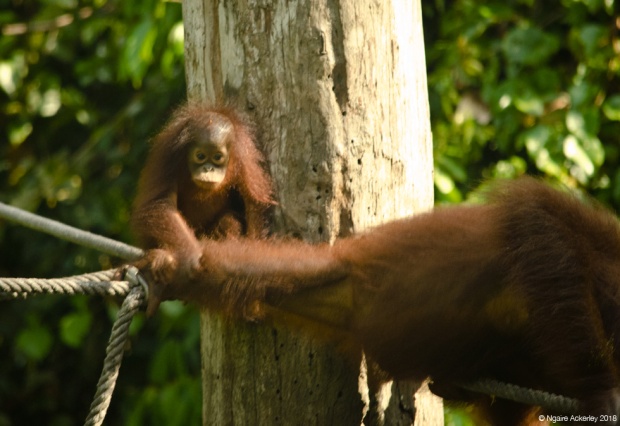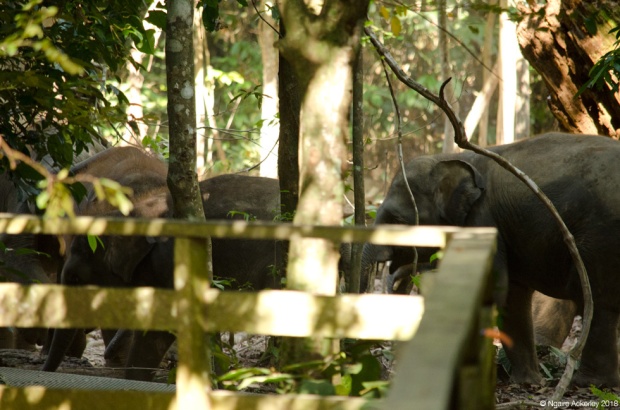Sun Bear and Sepilok Orangutan Wildlife Sanctuaries, Borneo
WARNING: CUTE PHOTOS AHEAD!

Orangutan, Sepilok Rehabilitation Centre, Borneo
Wild and free animals (or lack of) behind me, it was onwards to cute wildlife cared for in the popular sanctuaries of Borneo.
Sun Bear Conservation Centre

Sun Bear Conservation Centre, Borneo
My first intro to Sun Bears was several years ago, watching a documentary on the wildlife in Burma as it is opened up. I was horrified by what people do to sun bears. Imagine a warehouse of small cages with tubes and needles coming out of the bears. It was awful.
The Sun Bear Conservation Centre next to Sepilok Rehabilitation Centre welcomes you with an informative video about how the Sun Bears are rescued and rehabilitated. Jury is out if they ever actually get released into the wild again, but at least they live an okay life here at the centre, rather than being drained of their bile.
Sun Bears, also known as honey bears are the smallest bears in the world. They have bib shaped golden markings on their chests which is unique to this species. Their fur is short similar to a dogs. And they are super cute.

Young Sun Bear, Sun Bear Conservation Centre

Young Sun Bear, Sun Bear Conservation Centre

Young Sun Bear, Sun Bear Conservation Centre

Young Sun Bear, Sun Bear Conservation Centre
I think from memory there were about 40 Sun Bears at this centre and some had been there 10+ years. We only spotted 3 or 4 young ones and I wondered how crowded it would be when all 40 are out and about.
The rehabilitation centre allows you to adopt a Sun Bear to help protect and keep these bears alive. I’ve added links at the end of this blog post for more information.
Sepilok Orangutan Rehabilitation Centre

Orangutan, Sepilok Rehabilitation Centre, Borneo
Just around the corner is a vast centre that many orangutans calls home. The sanctuary is 43 sq km of protected land at the edge of Kabili Sepilok Forest Reserve.
We saw two youngish orangutans climbing in on ropes to eat/play on the feeding platform. They were very animated.

Orangutan climbing, Sepilok Rehabilitation Centre, Borneo

Orangutan eating, Sepilok Rehabilitation Centre, Borneo
Next was visiting the nursery – viewing the very young ones and their mothers through glass.

Orangutan baby, Sepilok Rehabilitation Centre, Borneo

Orangutan baby, Sepilok Rehabilitation Centre, Borneo

Orangutan baby eating, Sepilok Rehabilitation Centre, Borneo

Orangutan baby, Sepilok Rehabilitation Centre, Borneo
There are lots of young babies in the nursery (about 25) and then 60-80 young/adult orangutans on the reserve. On the very odd occasion they release them into the wild. Again, much like the sun bears this doesn’t happen often, but it is what the centre and the volunteers work towards. Speaking of volunteers, it’s a really long wait list, a long commit and a very expensive place to volunteer. The staff and volunteers work around the clock with the animals and have feeding times twice a day that people can come to see a few of the orangutans eat.

Young orangutan eating, Sepilok Rehabilitation Centre, Borneo

Young orangutan eating, Sepilok Rehabilitation Centre, Borneo

Young orangutan eating, Sepilok Rehabilitation Centre, Borneo
While I was a bit disappointed not to see an older orangutan and more, it was nice to see that there was lots of trees for the animals to live and play amongst. At least not too often that the animals are encouraged to be near humans… As we walked back from the nursery we were greeted by another playful orangutan right next to the boardwalk.

Orangutan hanging about, Sepilok Rehabilitation Centre, Borneo

Orangutan hanging about, Sepilok Rehabilitation Centre, Borneo

Orangutan playing about, Sepilok Rehabilitation Centre, Borneo

Orangutan playing about, Sepilok Rehabilitation Centre, Borneo

Orangutan playing about, Sepilok Rehabilitation Centre, Borneo
The night walk at the centre was a bit less comforting. They had two orangutans out for people to photograph, they looked a bit underweight and made me think that this place is possibly leaning a bit too much toward tourism that may affect the welfare of the animals. It’s another one of those places that you really have to weigh up the good they are doing and realise that they need to fund the centre to be able to look after the animals. But I think its up to the individual to decide whether or not its 100% for the wellbeing of the animals there.

Orangutan during night walk, Sepilok Rehabilitation Centre, Borneo

Orangutan during night walk, Sepilok Rehabilitation Centre, Borneo

Orangutan during night walk, Sepilok Rehabilitation Centre, Borneo
Sidenote, here’s a bad photo (blurry foreground) of the example of elephants that have nowhere to be released, so they get to live in a small enclosure like this. It’s heartbreaking. Borneo really needs to sort out its priorities and give the wildlife more habitats to be free and happy.

Elephants, Sepilok, Borneo
All in all, I was glad to finally see orangutan’s even if they weren’t in the wild. Most of the ones I saw looked happy and well cared for. So much better than being locked up in a cage in someone’s home.
Following is a few links which if you liked this blog post I recommend checking these out:
For the documentary I mentioned about Burma featuring the Sun Bears, check out Wild Burma: Natures Lost Kingdom here: https://www.bbc.co.uk/programmes/p01hsbr2.
For more information about adopting a Sun Bear check out the conservation center’s website at www.bsbcc.org.my.
For more information on Sepilok check out: https://www.orangutan-appeal.org.uk/about-us/sepilok-orangutan-rehabilitation-centre.
That’s nearly the end of my tour in Borneo and trip to Malaysia, but I’ll have one last post to share the last bits of the trip next week (hopefully).
